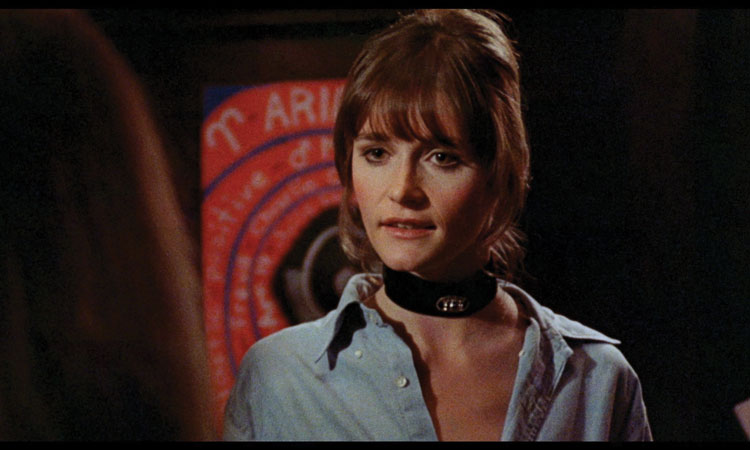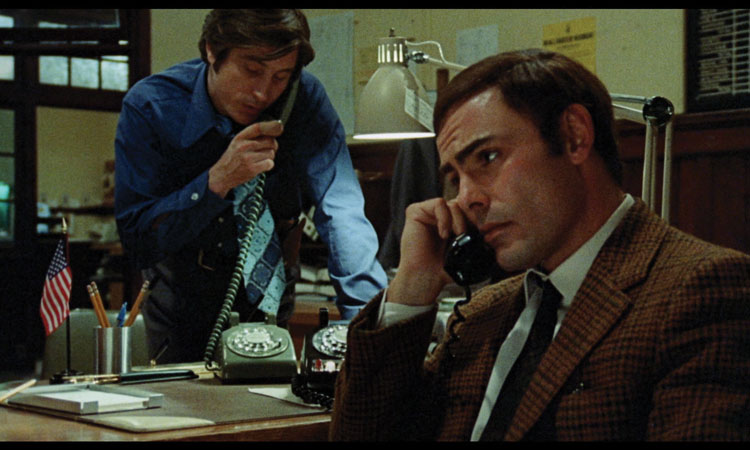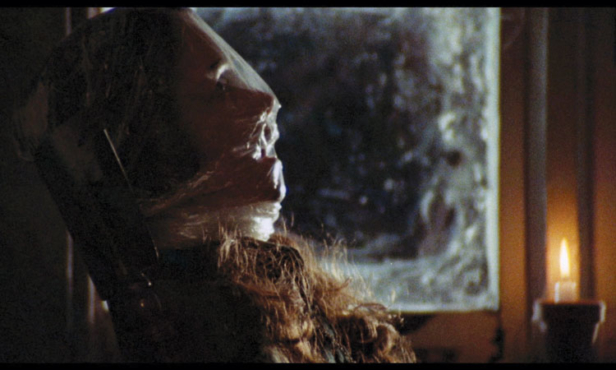Predating John Carpenter’s original Halloween by four years, Bob Clark’s 1974 seminal slasher Black Christmas, with its prowling unseen perpetrator’s point-of-view camera moves and creepy predominantly housebound premise, arguablay set the standard for the horror subgenre.
Of course, it’s loosely based on the old urban legend of ‘the babysitter and the man upstairs’, concerning a sitter who receives disturbing phone calls from a stalker who insists that she “check the children”, only for it to later emerge that the calls are actually coming from inside the house.
Clark’s imaginative take on the story centres on chilling events around a busy sorority house during the festive season, where a group of girls along with their boozy house mother become the prey of a disturbed prowler who places regular obscene phone calls. Veteran character actress Lynne Griffin portrayed the unfortunate first victim Clare Harrison. “At that point in my life I did play a lot of very sweet and straight, virginal characters, most of whom did meet quite horrendous demises,” she tells SciFiNow.
Griffin credits director-producer Clark for bringing much-needed levity during the production of this particularly murderous affair. “Because we were in an ensemble situation and we were actually filming in that one house, which was a real house that existed and looked exactly the way it looked, it was like being at a party,” she continues. “Bob Clark made it seem that way and every day going to work was really fun, we all kind of sat around and laughed.
“A lot of the time, when you’re working on a horror film, you’re not really aware of how serious it may eventually play because you’re having so much fun just re-creating it and doing the scenes. You’re not really aware until you see it which is when you experience how terrifying it is.”
Alongside Griffin, the sorority ensemble included such equally esteemed talent as Margot Kidder (who was fresh off the success of Brian De Palma’s slasher thriller Sisters), Olivia Hussey and Andrea Martin, along with Keir Dullea, Art Hindle and old genre reliable John Saxon fleshing out the (potentially homicidal) male love interests and local police Lieutenant, respectively.
Fifty year-old character player Marian Waldman brought literal high jinks with her portrayal of drunken sorority housemother Mrs Mac, who spends a considerable amount of screen time secretly scouring the house for hidden booze.
“What a wonderful character performance that is,” considers Griffin. “Not long ago I went to a Q&A and they asked me to sit and watch the film and little did I know that they were going to show it on an IMAX screen. [Therefore] I noticed things that I never had before. This included some of the subtleties in Mary’s performance and some of her subversive drunk scenes were particularly hilarious. She was just a very sweet woman and not like Mrs Mac at all. She was quite the lady!”
Somebody that perhaps did live up to her onscreen counterpart was the late great Margot Kidder as the foul-mouthed and promiscuous Barb. “Margot Kidder, bless her heart, did take the part very much to heart and in some scenes, felt it was necessary to go kind of method and be a little tipsy to get those absolutely right in terms of character,” reveals Griffin. “She had a certain looseness and ability to express herself quite fully I might say.”

Despite becoming renowned later on for directing Eighties sexploitation comedy series Porky’s, Bob Clark (who passed away in 2007) was equally at home with horror. “He had a tremendous sense of humour and was an absolutely lovely man. I think we all called him ‘Uncle Bob’,” remembers Griffin. “I was particularly enchanted with him when we were filming up in the attic. He would sit opposite me and I’d be in the rocking chair and he would be the one talking to me about what he wanted me to do. He was just so careful with me but at the same time it was all fun and experimentation. I was quite enchanted with him and his sense of humour.”
Indeed, even though the character of Clare was killed off early, she still had an integral part to play as an undiscovered corpse wrapped in plastic and rocking (and no doubt rotting!) in a chair in the attic.
“One of the reasons I was cast I believe is that I told them I was a good swimmer so I could hold my breath for quite a long time,” laughs Griffin. “When I saw it recently I thought ‘wow, she can really hold her breath for a long time!’. So, I guess that’s why I had a career often playing dead people or people who were about to [die]. However, that’s probably one of the more famous dead people I’ve played, no doubt due to the way they’ve used that image of me so much on the film’s posters.”
The aesthetics of the sorority residence, which is arguably a character in itself, was instrumental toward building the suspense and scares. Clark insisted on finding a house that resonated both threatening darkness and Christmas joy. Apart from a characterful exterior, the interior dynamics of the architecture were crucial too; in this case, a staircase that offered voyeuristic views of the busy ground floor from a middle landing, thus permitting those creepily omniscient point-of-view shots from the stalker.
As Griffin previously mentioned the house was a real location (which was situated in Toronto, Ontario in Canada) and one that she enjoyed revisiting in 2002 when she reunited with her onscreen love interest Art Hindle for the DVD extras documentary Black Christmas Revisited.
“Evidently, the people that own that house are quite amiable toward getting attention from others who come along and want to see where this film was made and they were very welcoming to us,” Griffin tells us. “I got to go back up into the attic, which is now all beautifully renovated and where I spend my time in the rocking chair with a plastic bag over my head. Of course the set decorators did wonders to that attic to make it look as creepy as possible for the film but basically all that wood work and the stairways are all pretty much the same.”
“From the beginning, I wanted to see whether I could get away with a film, and I don’t think it had ever been done, where you never saw the killer,” said Bob Clark in the aforementioned documentary. Indeed, perhaps an unsung hero of Black Christmas was camera operator Bert Dunk (aka Albert J Dunk) responsible for ‘playing the perpetrator’ by capturing those chillingly subjective shots from the killer’s point of view.
This included the virtuoso opening sequence, where the unseen predator approaches the exterior of the house, peers through the windows and eventually climbs the building’s trellis to make his secret entrance into the attic, down the ladder and into the interior of the house.
“Very clearly John Carpenter was influenced by Bob Clark’s work and the work of Bert Dunk; you can’t speak of him more highly because he created that steadicam and its not anything like the steadicams used today, which are so wonderfully malleable and lightweight,” elaborates Griffin. “He was sort of strapped into the thing… it’s actually Bert with the camera climbing up the outside of the house on the trellis and it’s actually Bert that strangles me in the closet too! He came through the plastic [clothes] bag and strangled me with the steadicam on him. Much of the scary work with the murders was Bert holding that camera and playing that character. He created that very terrifying cinema vérité POV of who it is that’s stalking you.”
Interestingly, Clark alludes to his influence on Carpenter during the DVD director’s commentary. The filmmaker goes as far to claim that the basic Halloween storyline was in fact his idea. “[John] was a big fan of Black Christmas. He was just beginning his career and had asked me […] whether I was ever going to do the sequel,” he said. “And I said, ‘no, this film was the last horror film I was going to do. […] I didn’t start out just to be a horror movie director’. ‘But if you did do a sequel what would you do?’ he asked. [I said] I would make it the following fall. Somehow the killer had been caught, he’d been institutionalised but he escaped one night and now he’s free in the community […] and I was going to call it Halloween.”

Whatever the truth behind their influences, both horror films would go on to become commercial hits and receive great international acclaim. Quentin Tarantino even proudly claims Black Christmas is his favourite movie to watch during the festive season.
“It’s amazing how many people say it’s one of their annual events to sit down and watch Black Christmas during the holidays,” says Griffin. “Well, there is White Christmas too and one of my favourite Bob Clark films is his other film about Christmas: A Christmas Story. He made two very different films about the same time of year!”
Perhaps what’s particularly sinister is the masterful climatic misdirection, which ultimately discloses that the emotionally unstable prime murder suspect Peter, who is killed in a violent struggle with his frightened girlfriend Jess, wasn’t the perpetrator after all. It also leaves Clare’s corpse still undiscovered in the attic and refuses to reveal the identity of the true killer behind the bloody slaughters, with the telephone continuing to ring ominously over the closing credits…
“As far as I know poor Clare is still sitting there and never was discovered but it doesn’t say much for the police department that they never actually looked up there!” considers Griffin. “Although, judging from the other scenes revolving around the police, they didn’t really create them as the most switched on bunch of people. Then again this is Bob Clark’s sense of humour and I loved that Black Christmas touched on so many things that were funny as well as frightening.”
Black Christmas is available on Blu-ray from 101 Films.
